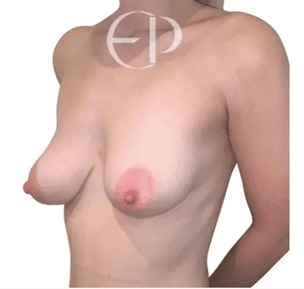If you have an idea of the results you want from your tuberous breast correction surgery, it is essential to manage your expectations, particularly for severely deformed breasts. Nevertheless, Dr Elena Prousskaia has performed countless tubular breast corrections giving her patients their confidence back.
“A patient’s confidence and well-being are normally very affected by how their breasts look. This surgery is truly life-changing.” – Elena Prousskaia, 2023
This article showcases the results of five women, all with different grades of tubular breasts. Then we outline some factors that may affect your results and possible side effects.
Click on one of the links to jump to that section
-
Realistic expectations for tubular breast correction results
We showcase Dr Elena’s work on tubular breast deformities
-
What can affect your plastic surgery results?
Factors such as small breasts, considerable breast augmentation or asymmetry can affect the outcome
-
What are the possible side effects of tuberous breast surgery?
There are always risks in plastic surgery; we address several of these
Realistic expectations for tubular breast correction results
Here we display a selection of tubular breast correction results. Elena Prousskaia is a specialist plastic surgeon and has performed cosmetic surgery to correct a broad range of tuberous breast syndromes. We explore tuberous breast types and procedures for five patients with different breast characteristics.
Patient A – Type I tuberous breast with mild asymmetry
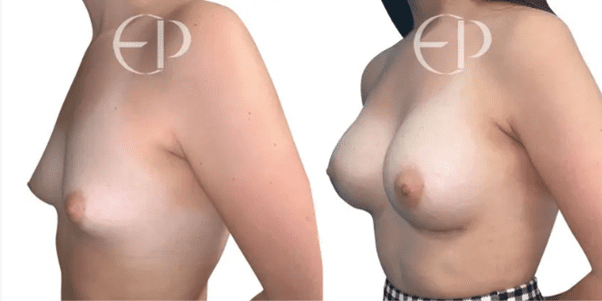
This patient had small breasts, with breast hypoplasia (underdevelopment) in the inner and lower portion of the breasts. This patient had minimal asymmetry to correct. Breast tissue reconstruction helps to create a fuller lower pole. Tissue expansion is necessary for creating space for the desired breast implant size.
“I am four weeks post-op, and I couldn’t be happier with the results… I’m so happy that I finally have the results I’ve always wanted.” – Anonymous TBS patient, 2023
Patient B – Type II tuberous breast with moderate asymmetry
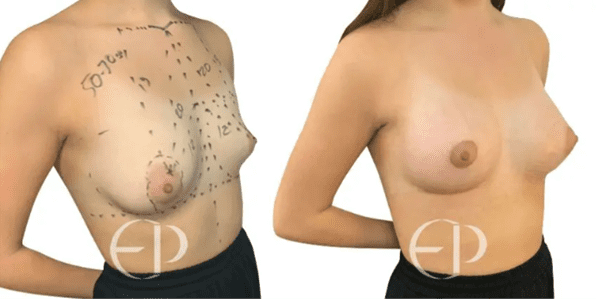
Patient B has relatively low breast volume, herniated areolas, breast hypoplasia in the lower, inner, and outer portions and moderate asymmetry. For this procedure, the areolas have been reduced using a doughnut-shaped incision. The breast has been remodelled to release the breast parenchyma from constriction. Finally, breast augmentation was performed to fix asymmetry and create a bigger breast size.
Patient C – Type III tuberous breasts with moderate asymmetry
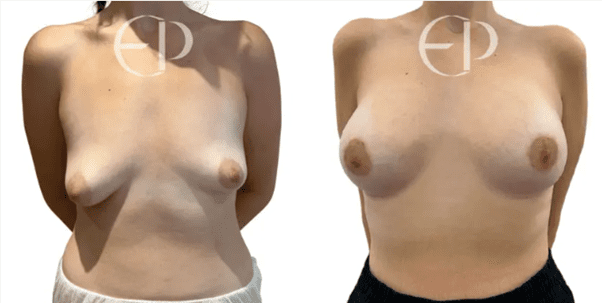
Patient C has a severe skin deficiency underneath the areola on the left breast; there is also considerable breast hypoplasia in the breast’s lower, inner and outer portions. The patient has a small breast base, asymmetry and the nipples have herniated the nipple-areola complex. The procedures to correct this tuberous breast deformity include tissue remodelling to release breast constriction, nipple reduction and tuberous breast augmentation. After recovery, this patient has full, symmetrical breasts and proportional areolas.
Patient D – Type IV tuberous breasts with mild asymmetry
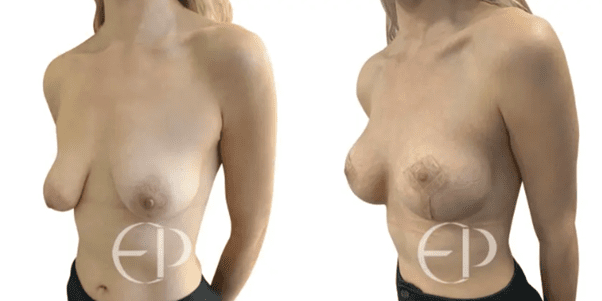
Patient D has severe breast drooping (elevated inframammary fold) and a small breast base. She also has underdevelopment in the lower pole of the breast and prominently herniated nipples. This patient has undergone a breast lift, nipple reconstruction and breast augmentation. The result is an improvement in breast volume, shape and proportion of the areolas.
Patient E – Type 0 tuberous breasts with mild asymmetry
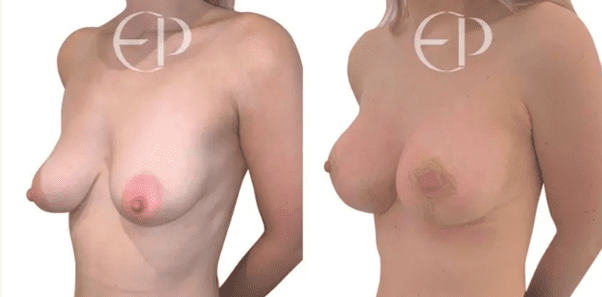
Finally, patient E has a relatively typical breast base, aside from slight drooping and constriction. The severe herniation of the nipple-areolar complex characterises this tuberous breast deformity. This patient has undergone breast tissue remodelling, nipple reduction and breast augmentation.
What can affect your plastic surgery results?
You can go into your consultation with an idea of your desired results. However, there are often limitations to what is possible. Take the time to consider your decision; you may not get absolute perfection.
“Elena was realistic and said that she would do the best surgery possible…but because of my daughter’s condition and how severe it was, she may not get absolute perfection… and she needed to be made aware.” – mother of TBS patient, 2017.
Here, we outline what could affect your results
- Small breasts – tubular breast surgery on small breasts may require a tissue expander for 2-3 months to allow for the size of your desired breast implant. Also, a smaller breast volume means you have less natural tissue to overlay the breast implant.
- Severe breast asymmetry – your surgeon will put a smaller implant in the larger breast. As a result, there will be more breast tissue to overlay a smaller implant and vice versa. A skilled surgeon can create good symmetry, but natural tissue always looks and acts differently from a breast implant.
- Severely herniated nipples – nipple herniation in one or both nipples requires an incision around the nipple to remove some breast tissue and skin around the areola. This procedure will leave a round-block scar around your areola.
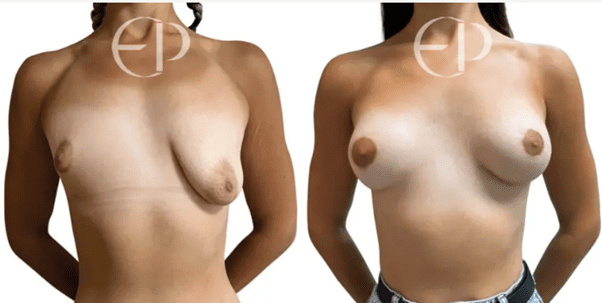
Furthermore, your aftercare will affect your recovery and results. We offer as many post-op aftercare visits as needed and provide a detailed guide on optimising your recovery. However, some patients can develop noticeable scarring without proper aftercare.
What are the possible side effects of tuberous breast surgery?
Your plastic surgeon will always discuss the possible risks at your consultation, but here we outline the four main ones.
- Keloid scarring – this kind of scarring is raised, thick and often discoloured. It can result from improper aftercare or a diet lacking the building blocks for collagen formation. Regularly massage your scars with a gentle moisturising cream or oil, apply topical collagen peptides and consume plenty of water, protein and vitamin C.
- Breast pain – although pain is to be expected after tubular breast surgery, some experience nerve pain for several months after the wounds have healed. This is due to nerves being disturbed during the procedure and taking a while to settle down.
- Changes or loss of sensation – your nipple sensitivity may change, particularly if your tuberous breast correction involves a nipple reduction or significant tissue remodelling.
- Capsular contracture – Some bodies build a layer of scar tissue around the breast implant during healing. Capsular contracture can cause your breasts to feel rigid.
“Elena explained the risks and was thorough with aftercare. She made sure I knew exactly what the surgery and recovery involved before moving ahead with anything.” – Anonymous TBS patient, 2022.
What to read next
What are the different types of tuberous breasts?


